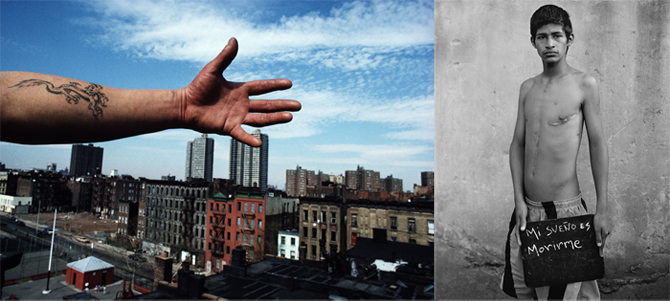
Cultural Memory Matters
Joseph Rodriguez and Martín Weber
October 22, 2010-March 12, 2011Curated by Robert Blake
Installation views
View Artist and Curator Bios
Press:
New Yorker Review of Cultural Memory Matters
New York Photo Review on Cultural Memory Matters
En Foco Blog: Martin Weber and Graciela Iturbide in Conversation
Special Events
Opening Reception: October 21, 6-9pm
601: In Dialogue
Robert Blake and Martín Weber:
Thursday, October 28, 2010, 7-9pm
Ruben Martinez and Joseph Rodriguez:
Friday, December 3, 2010, 7-9pm
Closing Reception: March 10, 2011, 6-9 PM
6:30-7:30 PM: Joseph Rodriguez and Martín Weber talk about their new and ongoing projects including Rodriguez’s work amongst Muslim youth in Sweden, featured as part of the BBC series Open Eye, and Weber’s (re)exploration of A Map of Latin American Dreams, this time in video format.
Cultural Memory Matters brings together over 50 photographs by two distinguished storytellers, Joseph Rodriguez and Martín Weber. Their images allow us to see the cracks, ruptures, and fissures in the representational fabric, exposing how cultural subjects are framed and naturalized. Presenting their photographs within a larger context - here in the form of a physical and digital archive - we establish renewed relationships between documentary practice, journalism and contemporary art. Photographic journeymen are often "field workers". They seek access, establish relationships, extract portraits, and make frequent return visits. Personal motives nurture, filter and fuel their work. On rare occasions they are exalted, but often theirs is an exhausting and difficult daily practice.
For more than three decades, Joseph Rodriguez has chronicled the stories and lives of Latino American individuals, families, and groups. Spanish Harlem, Rodriguez’s earliest color project, is an anthem that continues to guide his methodology and practice. It is a deeply troubling, melancholic love song for a community the artist seeks to redeem through images. Compassionate and critical, East Side Stories: Gang Life in East LA, documents the conflicts and contradictions of everyday ghetto life through images, essays, journal entries and interviews. Projected images of Still Here: Stories After Katrina, and Re-Entry introduce further iterations of Rodriguez’s work.
Rodriguez’s practice is emotional, participatory, and patterned like jazz: he shares, interacts, gets close, talks back, brings out, reflects and leaves, only to return again. He works with accomplished writers, community leaders, activists, media makers, and social workers. His motivation is profoundly personal, and political. In his images and texts one experiences a deeply felt, resilient, cultural and human resistance.
Rodriguez states: "I have a searing memory of returning home from my Catholic elementary school to find my stepfather nodding off, with a needle in his arm. I relived that memory in my own body—as a young adult I became a 'user.' Raised in violence, I enacted my own violence upon the world and myself. What saved me was the camera—its ability to gaze upon, to focus, to investigate, to reclaim, to resist, to re-envision. Over many years I have been imaging myself through the photographing of troubled adolescents, in prison and on the street. In doing so, I have tried to redeem both the other and myself, finding the other always capable of redemption."
The photographs in Martín Weber's, A Map of Latin American Dreams, were made over the course of fifteen years, 1992 through 2007. Weber made trips to Argentina, Brazil, Colombia, Cuba, Guatemala, Mexico, Nicaragua, and Peru. His subjects were invited to participate producing a collaborative picture, which includes the request: "Can you write down a wish or a dream?" Writing on small blackboards, their words offer testimony of traumatic memories of the past and hopes for the future, within the shared encounter of the present.
Weber writes: "Sharing their stories, these "dreamers" restore our awareness of individual and collective experience. In a globalized world, dreams are often reduced to commodity status. Countries and continents are frequently exploited as mere sources of trade. The histories of our communities can be made visible…Our destiny will change when we allow ourselves to imagine differently from what we were given."
Martín Weber has an uncanny ability to form new variations of collective memories. Slowing down the time it takes to make a single picture, Weber historicizes the present—photographing survivors young and old, while providing literal and lyrical evidence for the traumas and aspirations of Latin Americans. The lives chronicled by Rodriguez in the United States, and Weber's A Map of Latin American Dreams draw attention to alternative representations of the American continent, creating a new public record.
Robert Blake is an artist, photographer, and educator who directed The General Studies Program of the International Center of Photography, New York, 1985-2008. He is Founder of Lightaxe, a multimedia research and production company, New York/Paris. Blake is Director of Special Projects, 601Artspace, New York.
Images: (left) Joseph Rodriguez, Untitled (Arm in Sky, Spanish Harlem), 1987, color photograph, 11 13/16 x 17 3/4 in.
(right) Martín Weber, Mi sueño es morirme (My dream is to die), Medellin, Colombia, 2007, b/w Photograph, 50 x 40 in.
88 Eldridge St. New York, NY 10002
Tel: 212-243-2735
Open Thurs-Sun 1-6pm
© 601Artspace, 2018
